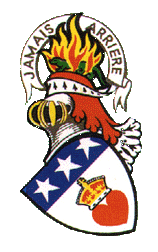   |
|
|
|
|
| ||||||
The Slaying of John Douglas at Little Moccasin Gap
By Emory L. Hamilton
It has been written that John Douglas was living in the vicinity of Abingdon at the time, but of this I can find no confirmation. He, at the time, was a young unmarried man, and his parents, Edward and Sarah George Douglas were living on a 400 acre tract of land on both sides of Clinch River at the Flour Ford in Scott County, VA, where they had settled in 1776. The Douglas family and that of Captain John Blackmore had intermarried. Sarah Douglas, a sister of the slain John, having married Thomas, a son of Captain John Blackmore, and Almore Douglas was married to a daughter of Captain John Blackmore to the Nashboro settlement when he rafted down the Clinch to that place in 1779. There was a connection between the Douglas, Benham and Hobbs families which may account for John Douglas’ friend William Benham being with him at the time of the slaying. For the foregoing data I am indebted to Gordon Aronhime, of Bristol, VA. A man named John Benham settled on the north side of the North Fork of Holston River in 1769. William Benham was likely his son. He, the elder Benham owned about a thousand acres of land along the Holston River, about four miles or less below the village of Holston. John Benham was evidently a brother-in-law of the elder Vincent Hobbs. Benham had a son named Vincent, and the Benhams and Hobbs lived next farms to each other, coming to the area about the same time. John Benham (died 1800) had a fort between those near Saltville (that of Jeremiah Harrison) and the Anderson Blockhouse near Big Moccasin Gap. Benham had built his fort before the Revolutionary War. William Benham married Mary Kendrick. John Douglas had probably been visiting with his friends and kindred, Benhams and Hobbs over at Holston, and was returning to the Clinch, along with William Benham when he was slain. At a court held for Washington County, VA, on September 30, 1777, Edward Douglas (his father) was granted administration of the estate of John Douglas, deceased, with his securities being William Wilson and Richard Stanton, the latter living on Stanton’s Creek, below Dungannon, in Scott County, VA. The appraisers of the estate were John Blackmore, Blackmore’s Fort, Andrew Davis who lived at the mouth of Stoney Creek, near Blackmore’s Fort, and Alexander Ritchie, Sr., who lived on Clinch River, below Dungannon in Scott County. Who were the two men that Captain Russell says were killed at Blackmore’s Fort?
Notes: 1. There is a large flat rock at the site 2. Another versions states: John Douglass, son of Colonel Edward Douglass and Sarah (George) Douglass, was killed by Indians while on a mission to them from Colonel Anthony Bledsoe. 3. The plaque reads as follows – To the Memory of JOHN DOUGLASS, scout killed by the Indians near this spot in 1776 while on the way back from Black’s Fort to warn the settlement of Castle Woods of an impending Indian raid. 4. There is a tenuous family link between Daniel Boone, through Queen Victoria Boone, who married Col. Judge Benjamin Pennebaker Douglas
Any contributions will be gratefully accepted
| |||||||||||||||||||||||||||||||||
|
The content of this website is a collection of materials gathered from a variety of sources, some of it unedited. The webmaster does not intend to claim authorship, but gives credit to the originators for their work. As work progresses, some of the content may be re-written and presented in a unique format, to which we would then be able to claim ownership. Discussion and contributions from those more knowledgeable is welcome. Last modified: Friday, 02 August 2024 |